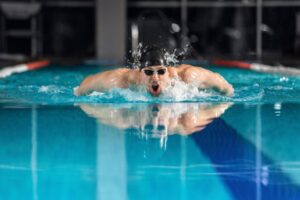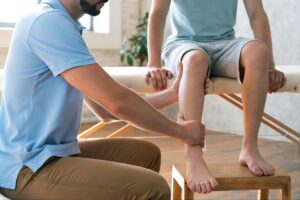Understanding Sports Injuries in Tennis, Golf & Swimming
- Tennis: Almost 50% of players report tennis elbow over their career. Shoulder impingement and trunk stiffness also increase risk.
- Golf: Over 50% of golfers face musculoskeletal injuries during their lifetime, most commonly in the lumbar spine (27%) and wrists (22%).
- Swimming: Between 40–91% of competitive swimmers report shoulder pain at some stage, with NCAA data confirming shoulders as the most vulnerable joint.

Why Pain Often Returns After “Rest”
- Limited joint mobility
- Fascial restrictions
- Poor neuromuscular coordination
- Weak scapular or trunk control
Comparative Overview: Tennis, Golf & Swimming Injuries
| Sport | Tennis | Golf | Swimming |
|---|---|---|---|
| Common Injuries | Lateral epicondylalgia (tennis elbow), rotator cuff irritation, shoulder impingement, trunk or hip stiffness that forces the arm to overwork. | Low back pain from repeated rotation, lead wrist or hand injuries, golfer’s or tennis elbow. Overuse plus swing faults equals trouble. | Swimmer’s shoulder, biceps tendinopathy, neck tightness, and scapular dyskinesis linked to technique faults or high yardage. |
| Rehab Focus with Advanced Physiotherapy & FMT™ |
|
|
|
| Return-to-Play Markers |
|
|
|
Why Rest & Generic Physio Fall Short
| Dimension | Rest Only | Generic Physiotherapy | Advanced Sports Rehab (FMT, Sport-Specific) |
|---|---|---|---|
| Pain Relief | Reduces pain and swelling initially | Addresses pain with modalities | Rapid, targeted pain relief plus root cause treatment |
| Tissue Healing | Passive—slower cellular repair, may delay recovery | Some guided movement; healing limited | Stimulates cellular repair with early, calibrated loading |
| Mobility | Stiffness and “rusty hinge” effect | Basic exercises; may not address kinetic chains | Manual therapy, sport-specific movement retraining for optimal range |
| Strength & Performance | No strength gains; risk of weakness | General exercises; not sport-specific | Advanced strength/power; tailored to athlete’s goals |
| Reinjury Risk | High risk—unaddressed biomechanical faults | May return to play with poor mechanics | Reduced—addresses underlying movement causality |
| Personalization | One-size-fits-all | Standard protocols; limited assessment | Individualized; full athlete profiling and tracking |
| Return to Sport Timeline | Often delayed; risk of chronicity | Variable; sometimes unstructured | Structured, phased, and performance-oriented |

How Functional Manual Therapy® (FMT™) makes a difference in sports rehab
Restore: Release and Mobilization
This initial phase focuses on reducing pain, freeing stiff joints, and restoring the full range of motion.
| Tennis elbow | Golfer’s back | Swimmer’s shoulder |
|---|---|---|
| Intensive manual therapy is used to mobilize the wrist and elbow joints. This releases tissue adhesions, normalizes joint mechanics, and immediately reduces pain, setting the stage for active recovery. | Hands-on techniques target thoracic and lumbar segments to unlock rotational mobility, reduce stiffness, and relieve low back pressure. | Manual therapy releases the rib cage, shoulder capsule, and tightened soft tissues especially around the scapula—to restore overhead motion and pain-free arm elevation. |
Retrain: Movement Pattern Re-education
| Tennis elbow | Golfer’s back | Swimmer’s shoulder |
|---|---|---|
| The athlete learns proper grip technique and efficient shoulder sequencing. This distributes forces away from the elbow and prevents recurring overload during strokes. | Trunk-hip sequencing drills are introduced, allowing the golfer to initiate rotation from the pelvis and thoracic spine instead of repetitive overuse of the lumbar area. Core First™ strategies ensure correct trunk engagement. | Retraining emphasizes scapular timing—specifically activating serratus anterior and lower trapezius muscles during swimming strokes. Proper posture and breathing mechanics are established to maintain shoulder health. |
Reload: Strengthening and Sport-Specific Endurance
| Tennis elbow | Golfer’s back | Swimmer’s shoulder |
|---|---|---|
| Eccentric loading exercises for wrist extensors build resilience, while endurance training enables repeated rallies without flare-ups. | The athlete advances to rotational core drills and partial-to-full swings, gradually increasing the intensity while monitoring for symptoms. | Advanced stroke endurance sets and drill-heavy practice help ensure the shoulder and scapular muscles can withstand swim volume across sessions, setting up the swimmer for safe, competitive returns. |
When to See a Functional Manual Therapist

- Night pain / disturbed sleep → may signal serious tissue injury or inflammation.
- Visible deformity, swelling, bruising → could indicate fracture, rupture, or dislocation.
- Numbness, tingling, radiating pain → suggests possible nerve involvement.
- “Pop” with rapid swelling / loss of function → often points to ligament or joint damage.
- Inability to bear weight or use limb → may mean structural injury needing urgent care.
- Symptoms persisting or worsening → requires advanced diagnostics and expert evaluation.
Your sport specific two weeks game plan: a simple checklist
- Keep conditioning up with low impact options while you reduce the aggravating skill.
- Restore mobility before chasing heavy strength numbers.
- Rebuild coordination: scapular timing, trunk–hip rotation, and grip mechanics.
- Progress volume before intensity and retest symptoms the next day.
- Prioritise sleep, hydration, and protein to support tissue repair.
Move smarter. Perform longer. Live better.
If you play tennis, golf, or swim, you do not have to stop. You need the right plan tailored to your body.
Ready to return stronger?
Request an Appointment at VARDĀN, Lajpat Nagar, New Delhi for a personalised Functional Manual Therapy assessment and a sport specific rehab plan.
Call us today at +91 011 43580720-22 / 9810306730
📅 Book your root-cause consultation at www.vardan.in
📍 Visit our advanced physiotherapy clinic in Delhi in Lajpat Nagar
Frequently Asked Questions
Mild cases can improve within a few weeks, while stubborn cases may take several months. Consistent load management, eccentric strengthening, and good technique are key. Surgery is usually considered only after a long course of structured conservative care.
Dial back intensity and volume. Focus on scapular control and technique first. Resume normal sets when you have near pain free motion and solid strength endurance without next day symptoms.




